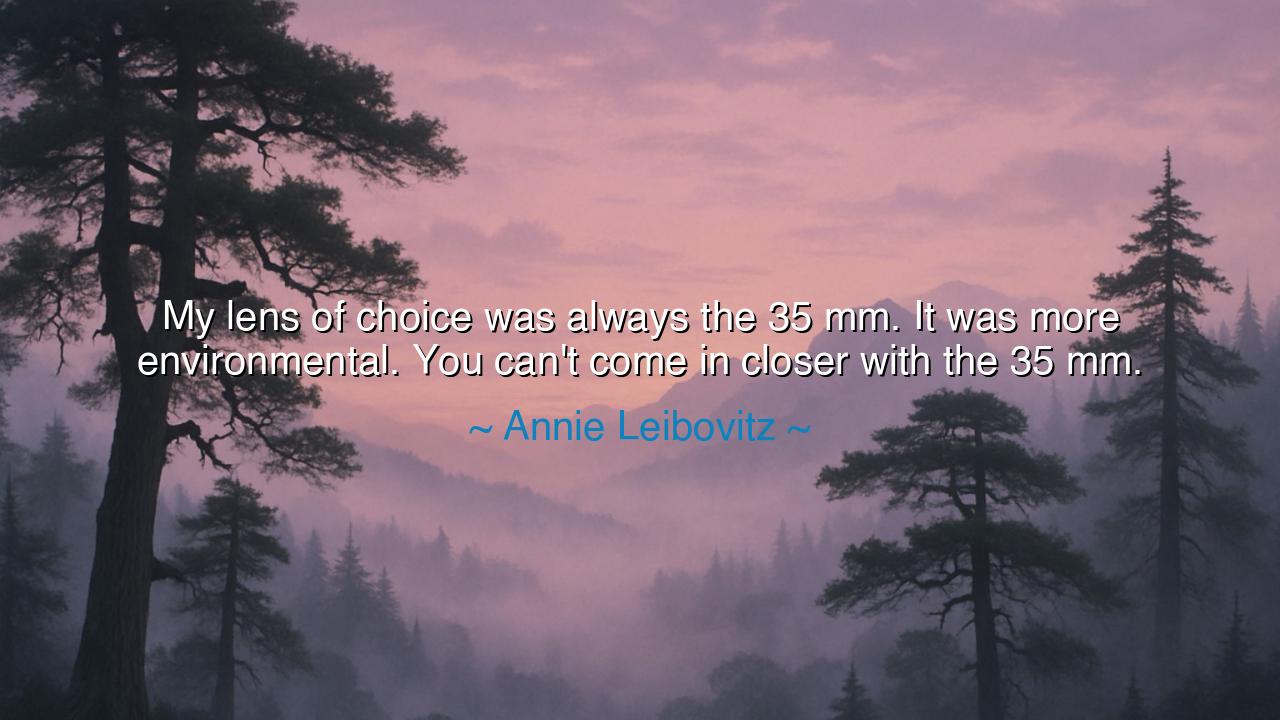
My lens of choice was always the 35 mm. It was more
My lens of choice was always the 35 mm. It was more environmental. You can't come in closer with the 35 mm.






In a voice both intimate and profound, Annie Leibovitz once said, “My lens of choice was always the 35 mm. It was more environmental. You can't come in closer with the 35 mm.” At first, these words may sound like the technical musings of a photographer—but within them lies a truth far deeper than craft. For Leibovitz, whose portraits have defined generations, the lens is not merely glass and metal; it is the eye of empathy, the bridge between artist and subject. Her choice of the 35 mm lens reflects a philosophy of seeing—of capturing not just the face, but the world that surrounds it. It is the vision of one who understands that every person is shaped by the environment they inhabit, that to know a soul, one must also see the space they dwell in.
The origin of the quote lies in Leibovitz’s early career as a photographer for Rolling Stone, where she traveled with musicians, activists, and cultural icons. She photographed not from afar, nor from sterile studios, but amid the chaos and color of life—concerts, streets, hotel rooms, and deserts. The 35 mm lens, wide and honest, allowed her to include context: the clutter, the crowd, the air around the subject. When she says, “You can’t come in closer,” she means not merely that the lens has physical limits, but that intimacy in art does not come from intrusion. True closeness, she implies, comes from respect—from allowing space for truth to breathe.
To the ancients, such an insight would not have seemed foreign. The philosopher Heraclitus taught that one cannot understand a person without understanding the world that flows around them. The river shapes the man, just as the man’s reflection shapes the river’s surface. So it is with Leibovitz’s photography. Her environmental eye seeks harmony rather than domination. She does not strip away the surroundings to isolate the subject; she reveals the web that binds person to place, emotion to atmosphere. The result is art that feels alive—each portrait a small universe of relationships, light, and air.
Consider her iconic photograph of John Lennon and Yoko Ono, taken just hours before Lennon’s death. In it, Lennon lies curled like a child, naked and vulnerable, while Yoko, fully clothed, lies beside him—her face serene, her eyes distant. The scene is not glamorous; it is raw, human, and deeply contextual. It is not just a picture of love, but of dependence, of tension, of two souls entwined and unequal in the moment. Had Leibovitz chosen a tighter lens, isolating their faces, the depth of the emotion—the story told by the space between them—would have been lost. Her 35 mm lens, her chosen vessel of vision, captured not just likeness, but truth.
In this way, her words reveal a sacred principle of perception: that closeness without understanding is intrusion. When she says one “can’t come in closer,” she speaks of boundaries—the recognition that art, like love, must allow the other to remain themselves. The environmental lens teaches patience; it invites the artist to step back, to observe, to witness life as it unfolds rather than forcing it into form. This wisdom transcends photography—it is the essence of all creation, all relationships. The painter, the writer, the teacher, the parent—all must learn the art of seeing without suffocating, of framing without controlling.
The history of art, too, is full of those who have understood this balance. The Renaissance master Leonardo da Vinci wrote that the artist must see not only the object, but the air around it—the “sfumato,” the smoke that connects light and form. In his Mona Lisa, the landscape and the woman are one; her mystery is inseparable from the mist behind her. Leibovitz carries this ancient lineage into the modern world, using her lens not to command reality, but to converse with it. Her work stands as a living reminder that the artist’s power lies not in manipulation, but in reverent observation.
Let this be the lesson drawn from her wisdom: do not always rush to come closer. Step back and see the whole. In life, as in art, we often focus too tightly, seeking to define, to possess, to dissect—and in doing so, we lose the vastness that gives meaning. The 35 mm way of seeing teaches balance: closeness with perspective, empathy with distance, love without control. It is a call to humility—to remember that every soul exists within an ecosystem of stories, histories, and unseen light.
So remember, children of vision: the truest art—and the truest understanding—comes not from narrowing your gaze, but from widening it. Walk through the world with a 35 mm heart, one that sees the whole scene, the background, the breeze, the silence around the sound. As Annie Leibovitz reminds us, it is in the space we allow between ourselves and others that love, and art, and truth are born.






AAdministratorAdministrator
Welcome, honored guests. Please leave a comment, we will respond soon